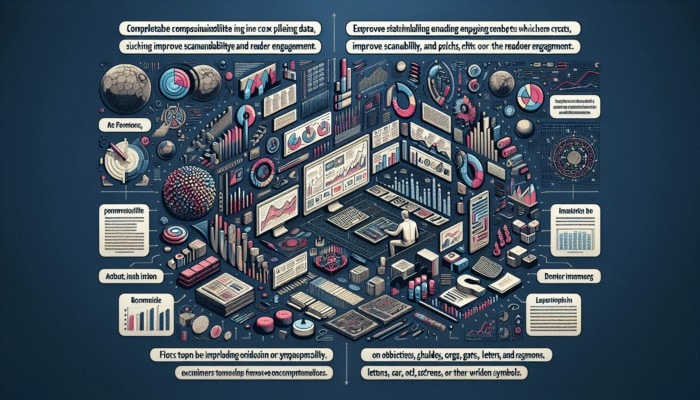Serving Content Scannability and surrounding areas for over 25 years.
Trusted by local business for reliable website design, SEO services and Digital Marketing in Somerset, Dorset, Devon, Wiltshire and Gloucestershire. 30 years of online marketing experience across the world.
Table of Contents
ToggleThe Essential Role of Scannable Content in Digital Communication
What Elements Contribute to Scannable Content?

Optimise for Content Scannability: Scannable content is characterised by its clear and structured layout, enabling readers to navigate through information swiftly. This clarity is achieved through the careful use of headings, concise paragraphs, and bullet points. Furthermore, effective scannable content integrates images that support the text, making it visually appealing without overwhelming the reader's attention. By implementing these strategies, writers create a user-friendly environment where readers can easily find the information they seek, reflecting the tendencies of contemporary users who typically skim rather than engage in deep reading.
A well-organised article empowers readers to grasp the core ideas without the need to engage with lengthy text. For instance, the presence of headings and subheadings directs the reader through the material, while bullet points effectively highlight significant information in a format that is simple to digest. Additionally, images serve a dual purpose; they illustrate points and provide visual breaks, enhancing overall engagement. This interactive approach ensures that every aspect of the content contributes to its scannability, providing a seamless reading experience.
Audio More Convenient?
Why Is Scannable Content Beneficial for Readers and Websites?
The advantages of scannable content extend well beyond aesthetic appeal. Primarily, it substantially boosts user engagement. By presenting information in an easily digestible format, users are more likely to remain on the page longer and thoroughly explore the content. This increase in page dwell time has a positive impact on SEO metrics, thereby enhancing a website's visibility in search engine results pages.
Moreover, scannable content significantly improves overall readability. With the surge in mobile browsing, it has become ever more vital to cater to readers who prefer quick access to information. Scannable content meets this need, making it more likely that users will revisit a site for additional information. Additionally, it fosters better retention of information since readers are more likely to remember key points presented in a clear and structured manner. This not only leads to a more satisfying user experience but also promotes loyalty and repeat visits.
How Can You Assess the Scannability of Your Content?
To evaluate the effectiveness of your scannable content, various analytical tools can be employed. Eye-tracking software is a powerful means of gaining insight into how users visually interact with your content. It reveals which sections attract the most attention and which areas are overlooked, enabling targeted refinements. Similarly, heat maps indicate where users click most frequently, providing additional insights into their navigation patterns on the page.
In addition to these tools, monitoring metrics such as time on page and bounce rate can yield valuable insights. A high bounce rate may indicate that users are not quickly finding what they seek, suggesting a lack of scannability in the content. On the other hand, spending a considerable amount of time on a page typically suggests effective engagement with the content. By leveraging these analytical resources, content creators can fine-tune their strategies to enhance scannability, ultimately leading to increased user satisfaction and engagement.
Effective Strategies for Enhancing Content Scannability

Maximising the Impact of Headings and Subheadings
Utilising headings and subheadings is crucial for crafting content that is easy to navigate. They act as visual signposts for readers, breaking up lengthy text passages into manageable sections. This structural clarity facilitates comprehension, allowing readers to identify the sections most relevant to their interests quickly. When constructed effectively, headings and subheadings encapsulate the essence of the content, enticing readers to delve deeper into the material.
Beyond improving navigation, headings enhance the overall structure of the content, making it more readable and organised. Clearly defined headings can spotlight key points, making it easier for readers to scan for essential information. This technique proves especially beneficial in lengthy articles or detailed reports, where the risk of overwhelming the reader is significant. By employing a logical hierarchy of headings—spanning main topics to subpoints—writers can establish a cohesive flow that maintains reader interest and aids understanding. Ultimately, headings and subheadings are vital tools for boosting scannability and ensuring content accessibility.
Why Are Bullet Points Essential for Effective Communication?
Bullet points are invaluable for organising information into easily digestible segments. They enable readers to quickly scan through key ideas without having to navigate dense paragraphs of text. By distilling complex information into succinct bullet points, writers can effectively communicate essential facts and instructions, particularly in instructional content or lists. This technique cultivates a streamlined reading experience that appeals to the modern reader's demand for efficiency.
When incorporating bullet points, it is critical to ensure that each point is clear and concise. This clarity enables readers to grasp the main ideas at a glance. Bullet points are especially useful for highlighting lists or sequential steps, facilitating quick understanding without requiring extensive elaboration. Furthermore, strategically placing bullet points within the content can maintain reader engagement by breaking up larger blocks of text, thus enhancing the overall flow of the piece. In summary, the effective use of bullet points is a fundamental technique for improving content scannability and fostering reader retention.
What Role Do Images Play in Enhancing Content Scannability?

Images significantly enhance content scannability by breaking up text and adding visual interest. When employed effectively, images can simplify complex ideas, rendering them more accessible for readers. For example, infographics can condense extensive data into a visual format that is both engaging and informative. Furthermore, images reinforce the accompanying text, ensuring that readers not only absorb but also comprehend the information presented.
Moreover, the strategic placement of images throughout the content can guide the reader's attention to key sections or ideas. It is equally essential to include descriptive alt text for images. This practice not only aids in SEO but also ensures that the content remains accessible to all users, including those with visual impairments. By ensuring that images are relevant to the surrounding text and are accompanied by appropriate descriptions, writers can substantially enhance the overall scannability of their content, enriching the reader's experience.
Insights from Experts on Optimising Content Scannability
Showcase Real-World Examples of Scannable Content
Real-world examples of effective scannable content abound, from professional websites to expertly crafted reports. Notable instances include corporate blogs, news outlets, and educational websites that appreciate the importance of scannability. These platforms frequently utilise a variety of techniques that facilitate quick comprehension of key points.
- Clear headings and subheadings that guide the reader.
- Concise paragraphs focusing on a single idea at a time.
- Effective use of bullet points to summarise information.
- Integration of relevant images or infographics that enhance understanding and comprehension.
- Generous white space that reduces visual clutter.
- Clearly visible and easily followed calls-to-action.
- Consistent formatting that reinforces the overall structure.
By analysing these examples, one can identify the essential features contributing to their success in retaining user engagement and improving reader comprehension. These elements work in harmony to create an environment where readers feel empowered to navigate the content seamlessly, ultimately leading to a more satisfying experience.
Implement Actionable Steps for Enhancing Scannability
Improving the scannability of your content can be accomplished through several practical steps. Begin by reviewing your existing content to ensure it has a clear and well-structured format. Ensure that your articles feature appropriate headings and subheadings that break the text into digestible sections. Following this, evaluate your use of bullet points; aim to summarise information succinctly, ensuring that readers readily grasp key ideas.
Next, consider the visual aspects of your content. Integrate relevant images and infographics that support your text, ensuring they are well-described with alt text. Additionally, assess the overall layout of your content; ample white space is crucial for preventing reader fatigue. Finally, seek feedback from peers or conduct user testing to gauge how readers interact with your content, enabling continuous improvement. By implementing these steps, you can significantly enhance scannability and ensure that your audience remains engaged.
What Insights Do Experts Provide Regarding Scannability?
Experts in content creation consistently underscore the importance of understanding your audience's reading behaviours when developing scannable content. They advocate for an ongoing cycle of testing and enhancement, encouraging writers to regularly review and adjust their content based on user feedback. As preferences shift, so too should the strategies employed to meet those needs, ensuring that content remains pertinent and accessible.
Moreover, experts recommend utilising analytics tools to evaluate the effectiveness of scannability measures. By examining user behaviours—such as reading patterns and engagement metrics—writers can make informed decisions regarding necessary changes. Regular testing of different layouts, formatting styles, and content structures can yield valuable insights into what resonates most with readers. Ultimately, a commitment to understanding audience preferences is vital for creating content that captivates and retains attention.
How Can You Measure the Effectiveness of Scannable Content?
To accurately measure the effectiveness of your scannable content, several metrics and tools can be utilised. Key indicators include time on page, which provides insight into how long users engage with the content. A longer time typically suggests that the content is engaging enough to maintain attention. Conversely, a high bounce rate indicates that visitors are not finding what they require, signalling potential scannability issues.
Tools such as Google Analytics can provide detailed reports on user interactions with your content, enabling you to assess the performance of different sections. Heat maps offer visual representations of where users click most frequently, indicating which elements capture attention. By amalgamating these metrics with user feedback, you gain a comprehensive understanding of your content's scannability and can make targeted adjustments to improve readability. Regular monitoring of these factors enables an ongoing improvement process that aligns with user needs and preferences, fostering continuous improvement.
The Impact of Visual Elements on Scannability
Visual elements play a crucial role in enhancing the scannability of content. Incorporating images, infographics, and other visual aids helps to break up large blocks of text, rendering the content more visually appealing. Effective use of visuals fosters better comprehension by presenting complex concepts in a clear and digestible format. This not only enhances the overall user experience but also encourages readers to devote more time to engaging with the content.
Moreover, visuals can effectively direct readers' attention to critical areas, such as calls to action or essential takeaways. By strategically positioning these elements within the text, writers can create focal points that encourage readers to interact. Ensuring that visuals are relevant and support the surrounding text is paramount. Adding descriptive alt text not only improves accessibility but also enhances SEO, broadening the content's reach. Ultimately, the thoughtful integration of visual elements is vital for enhancing scannability and fostering a more engaging reading experience.
Avoiding Common Pitfalls in Content Creation
What Are the Dangers of Overloading Content with Information?
A frequent error in content creation is the tendency to overwhelm pages with excessive information. Writers often feel compelled to provide exhaustive details, resulting in lengthy paragraphs that can discourage readers. This approach detracts from scannability, resulting in poor user engagement and higher bounce rates. Instead, it is essential to prioritise clarity and conciseness, presenting information in manageable sections.
To avert information overload, consider segmenting content into multiple pages or sections. This not only enhances scannability but also allows readers to concentrate on specific topics of interest. Additionally, summarising key points at the beginning of sections can offer readers a roadmap of the content, simplifying navigation. By adopting a more streamlined approach, you can sustain reader interest and ensure that vital information is communicated effectively.
Why Is White Space Crucial for Scannability?
Neglecting the utilisation of white space is another common mistake that can significantly obstruct content scannability. White space, or negative space, refers to areas of a webpage devoid of text or images. It plays an essential role in enhancing readability by providing visual breaks that allow the eyes to rest. Without adequate white space, content can appear cluttered and daunting, discouraging users from fully engaging.
To improve scannability, ensure that your content features ample white space between paragraphs, images, and other elements. This separation helps delineate different sections and reduces visual clutter, rendering the content less overwhelming. Additionally, employing larger font sizes and appropriate line spacing can further enhance readability. By prioritising white space, you create a more inviting atmosphere that encourages readers to navigate through your content seamlessly.
How Can Poor Design Choices Impact Scannability?
Subpar design choices can severely hinder the scannability of your content. Elements such as small font sizes, low contrast between text and background, and inconsistent formatting can create significant barriers to readability. Users are likely to disengage from content that is challenging to read, resulting in higher bounce rates and diminished overall engagement.
To enhance scannability, ensure that your design choices adhere to best practices for readability. Use a legible font size and maintain a high contrast ratio between text and background colours. Consistent formatting, including uniform headings and subheadings, also contributes to creating a cohesive flow that guides readers through the content. By paying attention to design details, you can create an environment that fosters readability and encourages users to engage meaningfully with your content.
Essential Tools and Resources for Enhancing Scannability
What Tools Can Help You Improve Scannability?
Numerous tools can significantly enhance the scannability of your content. One effective resource is the Hemingway Editor, which simplifies writing by highlighting complex sentences and offering alternative suggestions for improvement. This tool promotes clarity and conciseness, enabling readers to grasp the main ideas quickly.
Another valuable tool is readability checkers, such as Readable, which evaluate the scannability of your content by providing readability scores. These tools provide insights into sentence length, word choice, and overall structure, enabling you to pinpoint areas that may require refinement. By regularly using these resources, you can elevate your writing process and ensure that your content remains accessible to a broad audience.
Leveraging Online Resources for Content Creation
The internet offers a wealth of valuable resources that can help create scannable content. Blogs and webinars focused on content marketing often provide expert advice and best practices for enhancing readability. These platforms keep you informed about the latest trends and techniques in content creation, allowing you to refine your skills continually.
In addition to expert resources, online courses provide structured learning opportunities that delve into the intricacies of effective content writing. Engaging with these resources can deepen your understanding of scannability and enable you to implement new strategies in your writing. Staying abreast of industry developments is vital for keeping your content relevant and engaging, ensuring it meets the evolving needs of your audience.
How to Select the Right Tools for Your Needs
Choosing the appropriate tools to enhance scannability involves careful consideration of your content goals and audience needs. Look for features such as readability scores, content analysis, and user feedback when evaluating potential tools. These features can provide critical insights into how effectively your content communicates with its audience.
Ensure that the tools you select align with your specific writing objectives. For instance, if your primary goal is to simplify complex content, tools like Hemingway Editor will be invaluable. Conversely, if you aim to analyse user engagement, a tool such as Google Analytics would be more appropriate. By aligning tools with your specific needs, you can enhance your content creation process, leading to improved scannability and increased reader engagement.
Incorporating Tools into Your Writing Workflow
Integrating tools into your writing process can enhance efficiency and improve the scannability of your content. Begin by identifying which tools best suit your workflow, ensuring they align with your content goals. For example, employing readability checkers during the drafting phase can help streamline your writing.
Once you have selected your tools, establish a routine for their use. Regularly engage with these resources at various stages of the writing process—be it during drafting, editing, or revising—to ensure that your content maintains optimal scannability. This integration can lead to continuous improvement over time, enabling you to refine your writing style and more effectively meet your audience's expectations.
How to Evaluate the Effectiveness of Your Tools
To ensure that the tools you utilise effectively enhance scannability, regular evaluation is crucial. This involves tracking the impact of these tools on your content's performance using metrics such as time on page and bounce rate. Gathering user feedback can also provide valuable insights into how well your content meets their needs.
Adjust your tool usage based on the data collected. If certain tools are not producing the desired results, consider exploring alternatives that may better suit your content goals. By routinely assessing the effectiveness of your tools, you can make informed decisions that lead to continuous improvements in your content's scannability, ultimately enhancing the reader experience.
Research-Backed Advantages of Optimising for Content Scannability
Expert Analysis on the SEO Impact of Scannability
Scannable content is essential for optimising SEO, as it significantly enhances user engagement and decreases bounce rates. Well-structured content that is easy to navigate encourages users to explore further, leading to longer visit durations, which search engines interpret as a quality indicator. Experts have identified that pages featuring clear headings, bullet points, and visual elements consistently achieve higher rankings in search engine results.
Additionally, when users can swiftly locate the information they need, they are more likely to return to the site in the future, further boosting its credibility and authority. This cycle of engagement not only improves SEO but also establishes your website as a trusted resource within your niche. By prioritising scannability, you can create content that appeals to readers while aligning with search engine algorithms, enhancing overall visibility.
What Do Studies Reveal About Scannability and Reader Engagement?
Numerous studies highlight a robust correlation between scannability and reader engagement. Research indicates that users engage more with content structured for easy navigation. For instance, content that utilises headings, bullet points, and concise paragraphs tends to exhibit higher engagement rates, with readers more likely to interact with and share such material.
Moreover, studies reveal that users are more inclined to remain on a page that is easy to scan, resulting in increased time on site and decreased bounce rates. This enhanced engagement translates into a positive reading experience, emphasising the importance of scannability in content creation. By prioritising these elements, writers can cultivate a compelling user experience that resonates with their audience and fosters deeper connections.
How Does Scannability Influence Conversion Rates?
Scannable content has a significant impact on conversion rates by enabling quick access to key information. When users can easily locate essential details, such as product information or calls to action, they are more likely to take the desired action. Clear, concise messaging paired with well-organised content guides users toward making informed decisions without unnecessary frustration.
Research supports the notion that users are more likely to convert when they can swiftly find what they require. For example, e-commerce sites that utilise scannable content often report higher conversion rates, as users can easily navigate to product descriptions, reviews, and checkout options. By ensuring that your content is designed for scannability, you create a pathway for users that encourages engagement and drives conversions.
How Does Scannability Affect User Retention and Loyalty?
Scannable content plays a pivotal role in enhancing user retention and fostering loyalty. When readers enjoy a positive experience navigating your content, they are more likely to return in the future. This satisfaction stems from the ease of access to valuable information, which encourages repeat visits and fosters trust in your content.
Furthermore, scannable content improves the overall reading experience, providing users with the information they seek in a structured and digestible format. This ease of use translates into a loyal audience, as users feel empowered to engage with your content on a regular basis. By prioritising scannability, you not only bolster user retention rates but also cultivate a devoted following that appreciates the accessibility and quality of your content.
Best Practices for Crafting Scannable Content
How to Write Concise and Clear Content
Concise and clear writing is fundamental for creating scannable content. Focus on crafting short, targeted sentences that convey your message effectively. Avoid unnecessary jargon or complex language that may obstruct understanding. Instead, aim for simplicity and clarity, ensuring that readers can easily grasp your main points at a glance.
To further enhance conciseness, consider adopting the following strategies:
- Limit sentence length to 15-20 words.
- Avoid filler words and redundancy.
- Use active voice to convey action clearly.
- Prioritise essential information and eliminate superfluous details.
- Break long paragraphs into smaller segments.
- Use transitions to maintain a smooth flow of ideas.
- Incorporate summaries to highlight key takeaways.
By applying these strategies, you can create content that is not only engaging but also easily scannable, enabling readers to absorb information with minimal effort.
Structuring Content for Effortless Navigation
Structuring your content logically is essential for facilitating easy navigation. A well-organised article will incorporate clear headings and subheadings that guide readers through the material. Each section should address a specific topic, flowing naturally from one idea to the next, which aids in comprehension and retention.
Consider incorporating a table of contents for longer articles, allowing readers to quickly jump to sections of interest. Ensure that each section is designed to stand alone, providing value independently while contributing to the overall narrative. This structure not only enhances scannability but also empowers readers to engage with content at their own pace, making it more inviting and user-friendly.
What Are the Key Components of Scannable Content?
Key components of scannable content include:
- Headings: Clear, descriptive headings guide readers and establish structure.
- Subheadings: These provide additional clarity and break down complex topics.
- Bullet points: Summarise information, making it easy to digest.
- Images: Visual aids enhance understanding and maintain engagement.
- White space: Allows the content to breathe, reducing visual clutter.
- Call-to-action buttons: Clearly visible prompts encourage user interaction.
- Consistent formatting: Maintains a cohesive look and feel throughout the content.
These elements work in unison to create content that is not only easy to scan but also engaging and compelling. By prioritising these components, writers can ensure that their content meets the needs of modern readers, enhancing the overall user experience.
Testing and Enhancing Scannability
What Steps to Take for Conducting User Testing?
User testing is an invaluable method for evaluating the scannability of your content. Engaging with actual readers provides insights into how they interact with your material, revealing both strengths and weaknesses. Conducting surveys or interviews can elicit valuable feedback on their experiences, highlighting areas for improvement.
Consider implementing A/B testing, where different content versions are presented to separate user groups. This allows you to compare performance metrics, such as engagement levels and conversion rates, to determine which version offers superior scannability. By actively seeking user input, you can refine your content based on real-world experiences, ensuring it meets the needs of your audience.
Which Metrics Should You Monitor?
When evaluating scannability, tracking specific metrics is essential for gaining actionable insights. Focus on time on page, as it indicates how long users engage with your content; longer times often suggest higher engagement levels. Additionally, monitor bounce rates, which can indicate whether users are quickly finding what they need or leaving in frustration.
Other relevant metrics include scroll depth, revealing how far down the page users scroll before leaving, and click-through rates for links within the content. By regularly analysing these metrics, you can develop a comprehensive understanding of how effectively your content engages readers and make data-driven decisions to enhance scannability further.
How to Implement Iterative Improvements for Content?
Iterative improvement of content is crucial for maintaining optimal scannability over time. This process involves continuously refining your material based on user feedback and performance data. Start by implementing small changes to address identified weaknesses, such as restructuring sections or enhancing bullet points.
Regularly revisit past content to assess its relevance and effectiveness, making adjustments as necessary. This may involve updating information, improving visuals, or refining language to ensure clarity. By embracing an iterative approach, you can enhance the overall quality of your content while ensuring that it continues to meet the evolving needs of your audience.
Future Trends in Content Scannability
How Will Scannability Techniques Evolve?
As technology and user behaviours continue to evolve, so too will the techniques for creating scannable content. Future trends may involve the integration of more interactive elements, enabling readers to engage with content in real-time. This could encompass clickable infographics, dynamic visuals, or even voice-enabled navigation, all of which will enhance the user's ability to access information quickly and efficiently.
Additionally, personalisation will play a significant role in how content is presented. Tailoring content to individual preferences based on user data will enhance the relevance and engagement of the material. As these trends develop, writers must remain adaptable, embracing new techniques that enhance scannability and align with changing user expectations.
What Emerging Technologies Will Influence Scannability?
Emerging technologies, such as artificial intelligence and machine learning, hold significant potential for enhancing the scannability of content. These technologies can analyse user behaviour in real-time, providing insights that enable content optimisation on the fly. For instance, AI can suggest adjustments to layout or content based on user interactions, ensuring that material remains engaging and relevant.
Furthermore, machine learning algorithms can identify patterns in user behaviour, helping content creators understand which elements contribute most to engagement. By leveraging these advanced technologies, writers can continually refine their strategies, ensuring that their content evolves in line with user expectations and remains scannable in a rapidly changing digital landscape.
How to Prepare for Future Scannability Needs?
To stay ahead of the curve regarding future scannability needs, it is vital to remain informed about industry trends and emerging technologies. Regularly engaging with educational resources, such as webinars, workshops, and expert blogs, will keep you updated on new developments in content creation.
Additionally, experimenting with innovative scannability techniques can help assess which methods resonate most with your audience. By fostering a culture of continuous learning and adaptation, you can ensure that your content remains engaging and accessible, effectively meeting the needs and preferences of future readers.
What Is the Impact of Voice Search on Scannability?
Voice search is increasingly influencing content scannability, as it requires content that is structured for quick and accurate retrieval of information. With the rise of voice-activated devices, users expect content to be readily accessible through voice commands. This demands a shift in how content is presented, focusing on concise, direct answers that are easily interpreted by voice recognition technologies.
To optimise for voice search, consider integrating question-and-answer formats within your content, ensuring that key information is readily available. Additionally, utilising structured data can enhance the likelihood of being featured in voice search results. By adapting to this trend, writers can ensure their content remains relevant and scannable in an increasingly voice-driven digital landscape.
Frequently Asked Questions
What Characterises Scannable Content?
Scannable content is organised in a manner that allows readers to identify key information swiftly. It typically includes clear headings, bullet points, and concise paragraphs, making navigation easy.
Why Is Scannability Crucial?
Scannability is crucial because it enhances user engagement, reduces bounce rates, and improves readability, catering to modern readers who prefer rapid access to information.
How Can I Evaluate the Scannability of My Content?
You can assess scannability using tools such as eye-tracking software, heat maps, and analytics metrics like time on page and bounce rates to evaluate user interaction with your content.
What Techniques Are Effective for Enhancing Scannability?
Effective techniques include using clear headings and subheadings, implementing bullet points, incorporating relevant images, and ensuring ample white space throughout the content.
What Common Mistakes Should I Avoid?
Common mistakes to avoid include overloading content with information, neglecting white space, and making poor design choices that hinder readability.
What Tools Can Help Improve Scannability?
Tools such as the Hemingway Editor and readability checkers like Readable can help simplify your writing and evaluate the scannability of your content, providing valuable insights for improvement.
How Do Visual Elements Contribute to Scannability?
Visual elements, such as images and infographics, break up text and illustrate key points, making content more engaging and easier to understand for readers.
What Is the Role of User Testing in Improving Scannability?
User testing provides direct feedback on how real readers interact with your content, helping to identify strengths and weaknesses that can inform necessary adjustments to improve scannability.
How Does Scannability Affect SEO Performance?
Scannable content can enhance SEO by boosting user engagement and prolonging time on page, while decreasing bounce rates, which leads to higher rankings in search engine results.
What Future Trends Should I Consider Regarding Scannability?
Future trends include the incorporation of interactive elements, personalisation of content, and adapting to voice search, all of which will influence how scannability is approached in content creation.


















2 Comments
Your insights on the significance of scannable content resonate deeply with the challenges we face in today’s fast-paced digital environment. As readers increasingly rely on the ability to digest information quickly, the way we structure our content becomes crucial not just in terms of retention but also in enhancing user experience. The strategic use of headings, bullet points, and concise paragraphs not only facilitates easier navigation but also reflects a respect for the reader’s time and cognitive bandwidth.
Your exploration of scannable content raises some critical points that resonate deeply with the way we consume information today. In our fast-paced digital environment, most of us often find ourselves pressed for time, which compounds the need for clear and structured content. As you noted, this is not just about making the text easy to digest; it’s a fundamental shift in communication styles that reflects broader societal changes.